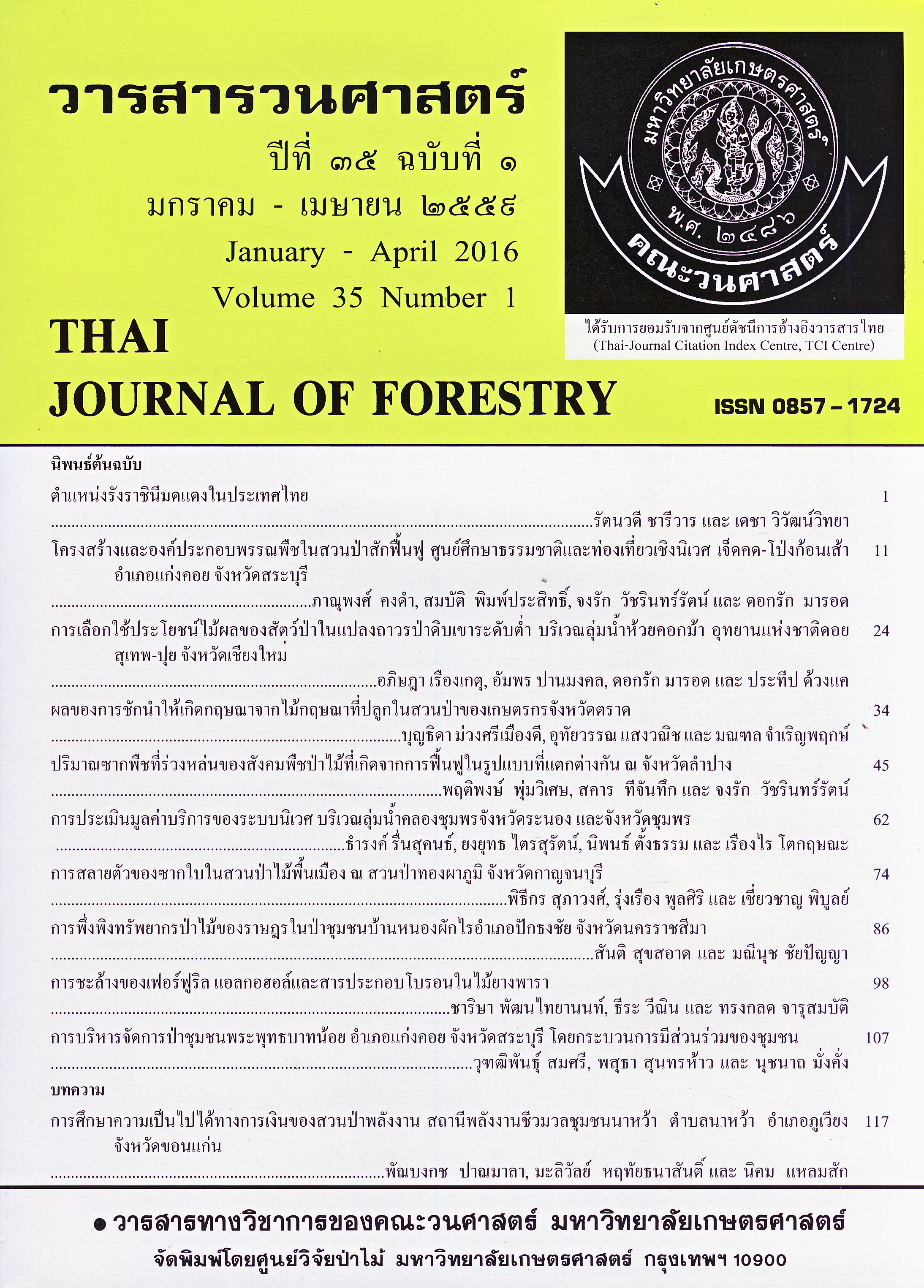โครงสร้างและองค์ประกอบพรรณพืชในสวนป่าสักฟื้นฟู ศูนย์ศึกษาธรรมชาติ และท่องเที่ยวเชิงนิเวศ เจ็ดคด-โป่งก้อนเส้า อำเภอแก่งคอย จังหวัดสระบุรี
Main Article Content
บทคัดย่อ
การศึกษาการรุกล้ำตามธรรมชาติของพันธุ์ไม้จากป่าดิบแล้งสู่พื้นที่ป่าฟื้นฟู ณ ศูนย์ศึกษาธรรมชาติและท่องเที่ยวเชิงนิเวศเจ็ดคด – โป่งก้อนเส้า อำเภอแก่งคอย จังหวัดสระบุรี ระหว่างเดือน มกราคม พ.ศ. 2557 ถึง มีนาคม พ.ศ. 2558 มีวัตถุประสงค์เพื่อศึกษาโครงสร้างและองค์ประกอบพรรณไม้ และปัจจัยกำหนดการปรากฏของพรรณไม้ ภายหลังการฟื้นฟูป่า โดยวางแปลงถาวร ขนาด 10 × 200 เมตร จำนวน 3 แปลง แบ่งเป็นแปลงย่อยขนาด 10 × 10 เมตร (จำนวน 60 แปลงย่อย) ติดเบอร์ต้นไม้ทุกต้นที่มีขนาดเส้นผ่านศูนย์กลางเพียงอก ตั้งแต่ 1 เซนติเมตร วัดขนาด และ
ระบุชนิด รวมถึงเก็บตัวอย่างดินทุกแปลงย่อย ผลการศึกษา พบชนิดพรรณไม้จำนวน 44 วงศ์ 106 สกุล 139 ชนิด มีความหนาแน่นและพื้นที่หน้าตัดไม้ เท่ากับ 4,304 ต้นต่อเฮกแตร์ และ 26.50 ตารางเมตรต่อเฮกแตร์ ตามลำดับ พรรณไม้ท้องถิ่นจากป่าดิบแล้งที่รุกเข้ามา ตั้งตัวได้ดีบริเวณพื้นป่าฟื้นฟู คือ พญารากดำ มะกายคัด มะเฟืองช้าง นวลเสี้ยน และกะหนาย ผลการวิเคราะห์การจัดลำดับหมู่ไม้ พบว่าปัจจัยแวดล้อม (เปอร์เซ็นต์การปกคลุมเรือนยอด ความชื้นดิน และความหนาแน่นรวมของดิน)มีผลต่อการปรากฏของหมู่ไม้ในระดับไม้ใหญ่ (r = 0.97) โดยความชื้นดินที่สูงเป็นปัจจัยกำหนดการปรากฏของพรรณไม้ป่าดิบแล้ง ส่วนเปอร์เซ็นต์การปกคลุมเรือนยอดต่ำหรือเรือนยอดเปิด และความหนาแน่นรวมของดินสูง มีอิทธิพลต่อการปรากฏของพันธุ์ไม้ในป่าผสมผลัดใบ กลุ่มพรรณไม้ที่มีช่วงการกระจายกว้างสามารถขึ้นได้ดีในช่วงการลดหลั่นของปัจจัยทั้งสามข้างต้น โดยเฉพาะบริเวณเขตป่าด้านใน และขอบป่าตอนกลาง เช่น แคหัวหมู โมกมันติ้วเกลี้ยง เป็นต้นดังนั้น การฟื้นฟูป่าควรคัดเลือกชนิดพรรณไม้ที่มีช่วงความทนทานทางด้านนิเวศวิทยากว้างและเหมาะสมต่อพื้นที่ และขั้นตอนการดำเนินการควรเริ่มฟื้นฟูจากบริเวณขอบป่าด้านในที่ติดกับป่าธรรมชาติจะช่วยทำให้การฟื้นฟูคืนสู่สภาพป่าดั้งเดิมได้รวดเร็วยิ่งขึ้น
Downloads
Article Details
ข้าพเจ้าและผู้เขียนร่วม (ถ้ามี) ขอรับรองว่า ต้นฉบับที่เสนอมานี้ยังไม่เคยได้รับการตีพิมพ์และไม่ได้อยู่ในระหว่างกระบวนการพิจารณาตีพิมพ์ลงในวารสารหรือสิ่งตีพิมพ์อื่นใด ข้าพเจ้าและผู้เขียนร่วม (ถ้ามี) ยอมรับหลักเกณฑ์และเงื่อนไขการพิจารณาต้นฉบับ ทั้งยินยอมให้กองบรรณาธิการมีสิทธิ์พิจารณาและตรวจแก้ต้นฉบับได้ตามที่เห็นสมควร พร้อมนี้ขอมอบลิขสิทธิ์ผลงานที่ได้รับการตีพิมพ์ให้แก่วารสารวนศาสตร์ คณะวนศาสตร์ มหาวิทยาลัยเกษตรศาสตร์ กรณีมีการฟ้องร้องเรื่องการละเมิดลิขสิทธิ์เกี่ยวกับภาพ กราฟ ข้อความส่วนใดส่วนหนึ่ง หรือ ข้อคิดเห็นที่ปรากฏในผลงาน ให้เป็นความรับผิดชอบของข้าพเจ้าและผู้เขียนร่วม (ถ้ามี) แต่เพียงฝ่ายเดียว และหากข้าพเจ้าและผู้เขียนร่วม (ถ้ามี) ประสงค์ถอนบทความในระหว่างกระบวนการพิจารณาของทางวารสาร ข้าพเจ้าและผู้เขียนร่วม (ถ้ามี) ยินดีรับผิดชอบค่าใช้จ่ายทั้งหมดที่เกิดขึ้นในกระบวนการพิจารณาบทความนั้น”
เอกสารอ้างอิง
Anusontpornperm, S., W. Sonkanha, S. Thanachit,I. Kheoruenromne and T. Artchawakom.2012. Soil Characteristics under Various Types of Forest in Sakaerat Environmental Research Station. Khon Kaen AGR. J. 40: 7-18
Asanok, L. 2006. Vegetation Structures of Forest Edges in Fragmented Montane Forest Caused by Shifting
Cultivation in Umphang Wildlife Sanctuary, Tak Province. M.S.Thesis, Kasetsart University.
Asanok, L., D. Marod, A. Pattanavibool and T. Nakashizuka. 2012. Colonization of tree species along an interior-exterior gradient across the forest edge in a tropical montane forest, western Thailand. Tropics Vol. 21 (3): 67-80
Clement, F.E. 1916. Plant Succession: analysis of the development of vegetation.
Carnegie Institute, Washington.
Kapos, V., E. Wandelli, J.L. Camargo and G. Ganade. 1997. Edge – related change in environment and plant responses due to forest fragmentation in Central Amazonia, pp. 45-54. In W.F.Laurance and R.O. Bierregaard, Jr, eds. Tropical Forest Remnants: Ecology, Management and Conservation of Fragmented Communities. Univ.
Chicago Press, Chicago.
Kutintara, U. 1999. Ecology Fundamental Basics in Forestry. Department of Biology, Faculty of Forestry, Kasetsart
University, Bangkok.
Lovejoy, T.E., R.O. Bierregaurd, Jr., A.B.Rylands, J.R. Malcolm, C.E. Quintela, L.E. Happer, K.S. Brown, Jr., A.H.
Powell, G.V.N. Powell, H.O.R. Shubart and M.B. Hays. 1986. Edge and other effects of isolation on amazon forest fragments. Conserv. Biol. 13: 257 - 285.
Marod, D. 1995. Secondary Successional Patter in the Mixed Deciduous Forest of Mae Klong Watershed Research
Station Changwat Kanchanaburi. M.S. Thesis, Kasetsart University.
Marod, D., U. Kutintara, H. Tanaka, and T. Nakashizuka, 1999. Structural dynamics in a mixed deciduous forest western Thailand. Journal of Vegetation Science 10: 777-786.
Marod, D., U. Kutintara, H. Tanaka, C. Yarwudhi and T. Nakashizuka. 2002. The effects of drought and fire on seed and seedling dynamics in a tropical seasonal forest in Thailand. Plant Ecol. 61: 41 - 57.
Marod, D., S. Sungkaew and W. Niamrat. 2003. The Invasion of Climax Species into Forest Plantations. Thai J. For. 22: 1-15.
Marod, D., U. Kutintara, H. Tanaka and T.Nakashizuka. 2004. Effects of drought and fire on seedling survival and growth under contrasting light conditions in a seasonal tropical forest. J.Veg.Sci.15: 691-700.
Marod, D., and U. Kutintara. 2009. Forest Ecology. Faculty of Forestry, Kasetsart University. Aksorn Siam Publ., Bangkok.
Marod, D., P. Duengkae, U. Kutintara, S.Sungkaew, C. Wachrinrat, L. Asanok and N. Klomwattanakul. 2012a. The
Influences of an Invasive Plant Species (Leucaena leucocephala) on Tree Regeneration in Khao Phuluang Forest,
Northeastern Thailand. Kasetsart J.(Nat. Sci.) 46: 39-50
Marod, D., P. Duengkae, L. Asanok and A. Pattanavibool. 2012b. Vegetation Structure and Floristic Composition
along the Edge of Montane Forest and Agricultural land in Um Phang Wildlife Sanctuary, Western Thailand.
Kasetsart J. (Nat. Sci.) 46: 162-180.
Marod, D., S. Sangkaew, A. Pamongkol and A. Jingjai. 2014. Influences of environmental factors on tree distribution of lower montane evergreen forest at Doi Sutep-Pui National Park, Chiang Mai Province. Thai J.For. 33 (3): 23-33
McCune, B. and M. J. Mefford. 2011. PC-ORD. Multivariate Analysis of Ecological Data. Version 6.08, MjM Software,
Gleneden Beach, Oregon, U.S.A.
Niamrat, W. and D. Marod. 2005. Seedling Establishment of Climax Species under the Eucalytus Plantation open Areas. Thai J. For. 24: 35-47.
Panichsuay, K. 2012. Natural Rehabilitation of Native Plant Species in Reforestation areas at Sakaerat Environment Research Station, Nakhon Ratchasima Province M.S. Thesis, Kasetsart University.
Parrotta, J.A., O.H. Knowles and J.M. Wunderle Jr. 1997. Development of floristic diversity in 10-year-old restoration forest on a bauxite mined site in Amazonia. For. Ecol. and Manage. 99: 21-24.
Shonnon, C.E. and W. Weaver. 1949. The mathematical Theory of Communication. University of Illinois Press, Urbana.
Sorensen, T. 1948. A method of establishing groups of equal amplitude in plant society based on similarity of species content. In U. Kutintara. Structure of the Dry Dipterocarp Forest. Ph.D. Dissertation, Colo. State Univ., Fort Collin., Colorado.
Tangsinmankong, W. 2004. Carbon Stocks in Soil of Mixed Deciduous Forest and Teak Plantation. M.S. Thesis,
Mahidol University.
Trisurat, Y. 2010. Biodiversity conservation. Department of Biology, Faculty of Forestry, Kasetsart University, Bangkok.
Williams-Linera, G., V. Domingguez-Gastelu and M.E. Garcia-Zurita. 1998. Micro environment and floristics of different edges in a fragmented tropical rain forest. Conserv. Biol. 12: 1091-1102.


